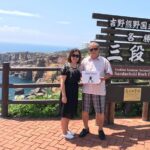The “uchiwa” (round fan) is a traditional Japanese handicraft with a long tradition. Originally from China, it is made by cutting a bamboo tube into narrow splinters which are then splayed out in the radial shape of a fan. Over both sides of this bamboo frame is pasted “washi” paper.
During the Heian period (794-1185), fans displaying intricate designs were used as ceremonial items at the Imperial court and as accessories by the aristocracy. They later became a common prop for performing arts like Japanese classical dancing, Noh plays and farce, and for the tea ceremony. Uchiwa were widely used among ordinary people in the Edo period. They were a necessity especially in summer to cool off and to keep mosquitoes away, as well as an essential tool for stoking up a cooking fire.
Near the famous Heian Shrine in Kyoto is a traditional uchiwa maker and store, Komaruya, which has been run by the same family since the Edo period (1600-1868). According to Komaruya’s own legend, their business of making uchiwa began on order of the Imperial court, using the bamboo that grew luxuriantly at Fukakusa, Kyoto. In the middle of the 17th century, the founder of Komaruya, heeding the advice of Gensei-shonin, a Buddhist priest, designed the original uchiwa with its distinctive long and slightly top-heavy shape and called it the Fukakusa uchiwa. It was said that Gensei-shonin, well known for his filial loyalty, believed this shape to be most fit for fanning for his parents. The popularity of this uchiwa quickly spread even to Edo, so that people said, “When you travel to Kyoto, don’t forget to buy a Fukakusa uchiwa as a souvenir.”
Keiko Sumii, the first daughter of the 10th generation of Komaruya, now runs the company. She was never brought up to take over the family business, but had firsthand knowledge of uchiwa craftsmanship since she was a child, watching her mother stew starch paste and helping their craftsmen in their work. She also often heard the history of her family from her grandmother. Ms. Sumii, when she talks about her memories, shows her enthusiasm for upholding the old traditions of Komaruya.
The uchiwa business is tough nowadays. People use uchiwa only occasionally as lifestyles have drastically changed. Sumii, therefore, has determined to produce newly-designed uchiwa appropriate to the needs of a new era. The Fukakusa uchiwa fell into disuse for a long time. She wished to introduce a good aspect of the Japanese traditional culture by reviving her family’s uchiwa business, hoping some tourists from abroad would buy them and appreciate the beauty of their craftsmanship.
The new uchiwa was designed in the motif of “Kyoto’s Must-See Sights Illustrated,” first published in 1780. Those colorfully painted original pictures show Kyoto’s festivals, annual events and people going on cherry blossom-viewing picnics, composing “tanka” poems and drinking sake. Some of them depict scenes of people enjoying shopping or cool evening breezes. “The illustrations printed on our uchiwa could be of some help for Japanese and foreigners alike to understand how people enjoyed life in Kyoto more than 200 years ago,” Sumii said. A descriptive note written by Iso-o Munemasa, the late professor emeritus at Ryukoku University, is attached to each uchiwa.
The new edition of the Fukakusa uchiwa has turned out to be rather popular. With this success, Ms. Sumii has become confident that, she and her daughter, who helped her mother with the project, can keep up the family tradition and generate ideas for more products. However, there is one matter of concern.
Komaruya has been laying in a stock of handmade uchiwa frames of bamboo from the town of Marugame in Shikoku. This town, which once prospered from uchiwa making, now finds itself with an acute lack of skilled craftsmen — people who can make uchiwa frames by hand are getting old and it is difficult to find young people willing to enter the trade. As a result, most uchiwa frames are machine-made in China. The craftsman, now 73 years old, who makes bamboo frames for Komaruya has no successor.
Faced with the drying up of her frame supply, Sumii decided to recruit young people who might be motivated in bamboo craftsmanship and send them to Marugame for training at her own cost, even though there is no guarantee they will take up the trade.
Sumii often uses special words like “en” (a Buddhist word for “encounter”). She firmly believes that, without good encounters, Komaruya would never have survived until the present day. She also believes her success and happiness are likewise supported by having encountered a great number of good people. Thanks in no small part to a certain “en,” Komaruya’s relationship with Marugame started many years ago, when the lord of Marugame came to Kyoto and left one of followers to learn uchiwa making at Komaruya. Such an auspicious encounter should still be treasured, even now, centuries later. This is why she wants to do what she can for Marugame.
Kyoto’s old people still believe that the uchiwa is properly used, not to fan oneself, but to fan others. For them, the uchiwa is a small tool for expressing gratitude, respect and sincere appreciation for others. Sumii said, “It would be great if our Fukakusa uchiwa could be used to ease stress and make others feel happy.”



